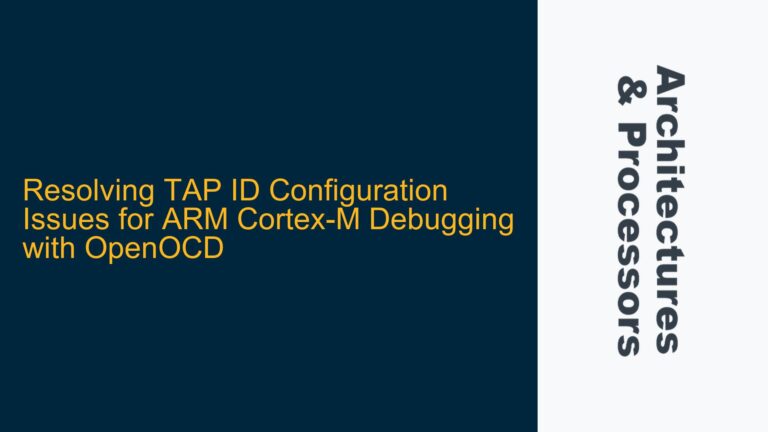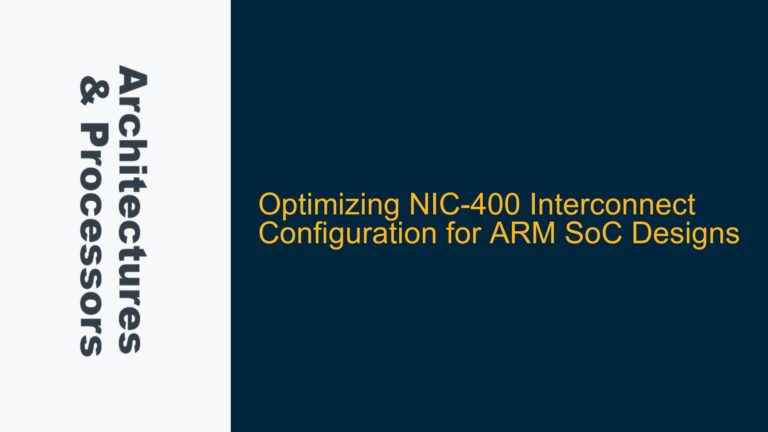Understanding the Basics of ARM Cortex-M Microcontroller Architecture
The ARM Cortex-M series is a group of 32-bit RISC ARM processor cores licensed by Arm Holdings. These cores are optimized for low-cost and energy-efficient integrated circuits, making them ideal for microcontroller applications. The Cortex-M series includes several variants, such as Cortex-M0, Cortex-M3, Cortex-M4, and Cortex-M7, each with different performance and feature sets tailored to specific application requirements.
The Cortex-M architecture is designed to be simple and efficient, with a focus on reducing both power consumption and silicon area. It features a streamlined instruction set, a nested vectored interrupt controller (NVIC) for efficient interrupt handling, and a memory protection unit (MPU) for enhanced security. The Cortex-M cores also support various sleep modes to further reduce power consumption, making them suitable for battery-powered devices.
To begin designing an SoC based on the Cortex-M architecture, it is essential to understand the core components and their interactions. The primary components include the processor core, memory subsystems, peripherals, and interconnect fabrics such as AMBA (Advanced Microcontroller Bus Architecture). The AMBA protocol family, which includes AHB (Advanced High-performance Bus), APB (Advanced Peripheral Bus), and AXI (Advanced eXtensible Interface), defines the communication standards between these components.
The Cortex-M cores are typically integrated with on-chip flash memory for program storage and SRAM for data storage. The memory map is predefined, with specific address ranges allocated for code, data, peripherals, and system control. Understanding the memory map is crucial for configuring the memory subsystems and ensuring proper access to peripherals and other resources.
In addition to the core and memory subsystems, the Cortex-M architecture supports a wide range of peripherals, including timers, communication interfaces (UART, SPI, I2C), analog-to-digital converters (ADC), and GPIOs (General-Purpose Input/Output). These peripherals are essential for interfacing with external devices and sensors, and they are typically accessed through memory-mapped registers.
Identifying Key Challenges in ARM Cortex-M SoC Design
Designing an SoC based on the ARM Cortex-M architecture presents several challenges, particularly for beginners. One of the primary challenges is understanding the complexity of the AMBA protocols and how they facilitate communication between the processor core, memory, and peripherals. The AHB and APB buses are commonly used in Cortex-M designs, with AHB serving as the high-performance system bus and APB used for lower-speed peripherals.
Another challenge is configuring the memory subsystems to meet the performance and power requirements of the target application. This involves selecting the appropriate types of memory (e.g., flash, SRAM, DRAM) and optimizing their organization and access patterns. The memory map must be carefully designed to ensure that all components can access the required resources without conflicts.
Power management is another critical aspect of Cortex-M SoC design. The Cortex-M cores support multiple low-power modes, such as Sleep, Deep Sleep, and Standby, which allow the processor to conserve energy when idle. However, implementing effective power management requires a deep understanding of the power domains, clock gating, and power gating techniques. Additionally, the design must account for the power consumption of peripherals and other components, which can significantly impact the overall energy efficiency of the SoC.
Interrupt handling is another area that can be challenging for beginners. The Cortex-M cores feature a nested vectored interrupt controller (NVIC) that allows for efficient handling of multiple interrupts with different priorities. However, configuring the NVIC and writing interrupt service routines (ISRs) requires a solid understanding of the interrupt architecture and the interaction between the processor core and peripherals.
Finally, verification and testing are critical steps in the SoC design process. Ensuring that the design meets the functional and performance requirements involves extensive simulation and debugging. This includes verifying the correctness of the AMBA bus transactions, memory access patterns, and peripheral interactions. Additionally, the design must be tested for timing closure, power consumption, and compliance with the ARM architecture specifications.
Step-by-Step Guide to Designing and Verifying an ARM Cortex-M SoC
Step 1: Define the System Requirements and Architecture
The first step in designing an ARM Cortex-M SoC is to define the system requirements and architecture. This involves identifying the target application, performance requirements, power constraints, and any specific features or peripherals that are needed. Based on these requirements, the appropriate Cortex-M core variant should be selected, along with the necessary memory subsystems and peripherals.
The system architecture should be defined in terms of the major components and their interactions. This includes the processor core, memory subsystems (flash, SRAM, DRAM), peripherals (timers, communication interfaces, ADCs, GPIOs), and interconnect fabrics (AHB, APB). The memory map should be designed to allocate address ranges for each component, ensuring that there are no conflicts and that all resources are accessible.
Step 2: Configure the AMBA Bus Fabric
The next step is to configure the AMBA bus fabric, which includes the AHB and APB buses. The AHB bus is used for high-performance communication between the processor core, memory subsystems, and high-speed peripherals. The APB bus is used for lower-speed peripherals and is typically connected to the AHB bus through a bridge.
The bus fabric should be configured to meet the performance and bandwidth requirements of the system. This involves setting up the bus arbitration, addressing, and data transfer protocols. The AHB bus supports burst transfers, split transactions, and multiple bus masters, which can be leveraged to optimize performance. The APB bus is simpler and supports single transfers, making it suitable for low-speed peripherals.
Step 3: Implement the Memory Subsystems
The memory subsystems are a critical part of the SoC design and must be carefully implemented to meet the performance and power requirements. The on-chip flash memory is used for program storage, while the SRAM is used for data storage. The memory map should be designed to allocate address ranges for each memory type, ensuring that the processor core and peripherals can access the required resources.
The memory subsystems should be optimized for access patterns and power consumption. This may involve implementing memory controllers, caches, and power management techniques such as clock gating and power gating. The memory access patterns should be analyzed to identify potential bottlenecks and optimize the memory organization and access timing.
Step 4: Integrate and Configure Peripherals
The next step is to integrate and configure the peripherals, which include timers, communication interfaces (UART, SPI, I2C), ADCs, and GPIOs. These peripherals are essential for interfacing with external devices and sensors, and they are typically accessed through memory-mapped registers.
Each peripheral should be configured according to the system requirements, including setting up the clock sources, interrupt priorities, and data transfer protocols. The NVIC should be configured to handle interrupts from the peripherals, with appropriate priority levels and interrupt service routines (ISRs) defined for each peripheral.
Step 5: Implement Power Management Techniques
Power management is a critical aspect of Cortex-M SoC design, particularly for battery-powered devices. The Cortex-M cores support multiple low-power modes, such as Sleep, Deep Sleep, and Standby, which allow the processor to conserve energy when idle.
The power management techniques should be implemented to minimize power consumption while meeting the performance requirements. This may involve configuring the power domains, clock gating, and power gating for the processor core, memory subsystems, and peripherals. The power consumption of each component should be analyzed to identify opportunities for optimization.
Step 6: Verify and Test the SoC Design
The final step is to verify and test the SoC design to ensure that it meets the functional and performance requirements. This involves extensive simulation and debugging, including verifying the correctness of the AMBA bus transactions, memory access patterns, and peripheral interactions.
The design should be tested for timing closure, power consumption, and compliance with the ARM architecture specifications. This may involve using simulation tools, such as ModelSim or VCS, to simulate the design and identify potential issues. Additionally, the design should be tested on a hardware platform, such as an FPGA, to validate the functionality and performance in a real-world environment.
Step 7: Optimize and Iterate
After the initial verification and testing, the design should be optimized and iterated to address any issues and improve performance. This may involve refining the memory subsystems, optimizing the bus fabric, and fine-tuning the power management techniques. The design should be re-verified and tested after each iteration to ensure that the changes have the desired effect.
In conclusion, designing an ARM Cortex-M SoC is a complex but rewarding process that requires a deep understanding of the Cortex-M architecture, AMBA protocols, and system-level design principles. By following a systematic approach and leveraging the available tools and resources, it is possible to create a high-performance, energy-efficient SoC that meets the requirements of the target application.






